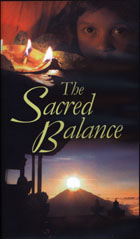
The Sacred Balance 2003
Distributed by Bullfrog Films, PO Box 149, Oley, PA 19547; 800-543-FROG (3764)
Produced by Robert Lang, Kensington Communications
Directed by Robert Land, Kensington Communications
VHS, color, 4 tapes, 53 min. each
Jr. High - Adult
Biology, Ecology, Environmental Studies
Date Entered: 02/04/2004
Reviewed by Barbara Butler, University of Oregon Institute of Marine BiologyThe Sacred Balance is adapted from David Suzuki’s book of the same name and is presented in four parts: Journey into New Worlds; The Matrix of Life; The Fire of Creation; and Coming Home. Each part can be purchased separately or as a set. Suzuki is a well known ecologist and he uses this documentary to demonstrate that the earth is a living balance of air, water, soil and energy. Each of the four segments can be viewed individually but Suzuki introduces the topic in the first part and offers some conclusions in the last segment. This series will be of interest to adult audiences but because of the interdisciplinary topic the discussion is too complex to be enjoyed by high-school and younger viewers.
The audio and video quality is excellent, but the concepts illustrated by various vignettes would be clearer if presented in a more seamless fashion. Journey into New Worlds invites us to rediscover our place on earth and discusses “patterns of collaboration”. Examples used in this segment include Tibetan monks creating a sand Mandela, ant colony and bee hive cooperation, translation of heart EKG tracings into music and the coining of the word Gaia to describe the planet as a living entity. The Matrix of Life makes use of clips from the Ganges River, South African mines, Lake Mead, Shark Bay Australia and elsewhere to illustrate the ubiquitous nature of water and the importance of water to all life on earth. Fire of Creation introduces the “big bang” concept and discusses how humans use and revere fire. In Coming Home Suzuki illustrates that people cannot survive alone and that humans must cooperate. He uses examples from both Inuit hunting parties and inner city dwellers. He concludes by saying that “Nothing exists alone. We are creatures of the living earth held together in the sacred balance”.
This video is appropriate for public library collections.